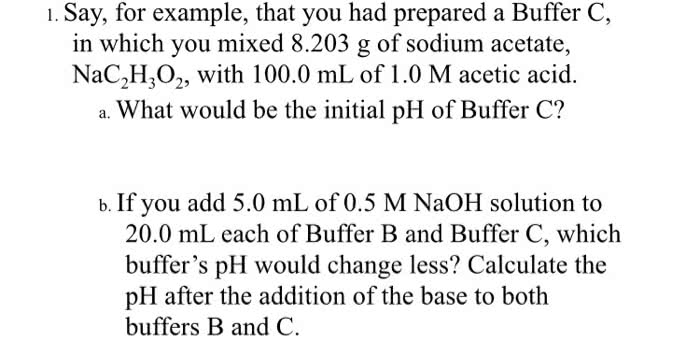Two buffers are prepared by adding an equal number of moles of formic acid (HCOOH) and sodium formate (HCOONa) to enough water to make 1.00 L of solution. Buffer A is prepared using 1.00 mol each of formic acid and sodium formate. Buffer B is prepared by using 0.010 mol of each. (a) Calculate the pH of each buffer. (b) Which buffer will have the greater buffer capacity? (c) Calculate the change in pH for each buffer upon the addition of 1.0 mL of 1.00 M HCl. (d) Calculate the change in pH for each buffer upon the addition of 10 mL of 1.00 M HCl.



b) The buffer made from 1.00 mol of each component has a greater buffer capacity, as it can accept greater amount of strong acid or strong base without changing a pH value significantly. The greater is the concentration of the buffer components, the greater is the buffer capacity.
c) The answer in part b) will be confirmed in this part. Adding 1.00 mL of 1.0 M HCl we are adding:

The HCl added reacts with HCOONa:
HCOONa + HCl  HCOOH + NaCl
HCOOH + NaCl
The number of moles of buffer components after addition of HCl:


The pH change is negligible.


The pH of a buffer decreases by 0.09 pH units.
c) Adding 10.0 mL of 1.0 M HCl we are adding:

The HCl added reacts with HCOONa:
HCOONa + HCl  HCOOH + NaCl
HCOOH + NaCl
The number of moles of buffer components after addition of HCl:


The pH changes by 0.01 units.

There is no basic component of a buffer anymore, so the pH is calculated as a pH of a weak acid:
HA H+ + A–
H+ + A–
Starting conc. (M):0.02000Change in conc.–xxxEquilibrium conc.0.020 –xxx



Two buffers are prepared by adding an equal number of moles of formic acid (HCOOH) and sodium formate (HCOONa) to enough water to make 1.00 L of solution. Buffer A is prepared using 1.00 mol each of formic acid and sodium formate. Buffer B is prepared by using 0.010 mol of each. (a) Calculate the pH of each buffer. (b) Which buffer will have the greater buffer capacity? (c) Calculate the change in pH for each buffer upon the addition of 1.0 mL of 1.00 M HCl. (d) Calculate the change in pH for each buffer upon the addition of 10 mL of 1.00 M HCl.
b) The buffer made from 1.00 mol of each component has a greater buffer capacity, as it can accept greater amount of strong acid or strong base without changing a pH value significantly. The greater is the concentration of the buffer components, the greater is the buffer capacity.
c) The answer in part b) will be confirmed in this part. Adding 1.00 mL of 1.0 M HCl we are adding:
The HCl added reacts with HCOONa:
HCOONa + HCl HCOOH + NaCl
The number of moles of buffer components after addition of HCl:
The pH change is negligible.
The pH of a buffer decreases by 0.09 pH units.
c) Adding 10.0 mL of 1.0 M HCl we are adding:
The HCl added reacts with HCOONa:
HCOONa + HCl HCOOH + NaCl
The number of moles of buffer components after addition of HCl:
The pH changes by 0.01 units.
There is no basic component of a buffer anymore, so the pH is calculated as a pH of a weak acid:
HAH+ + A–


